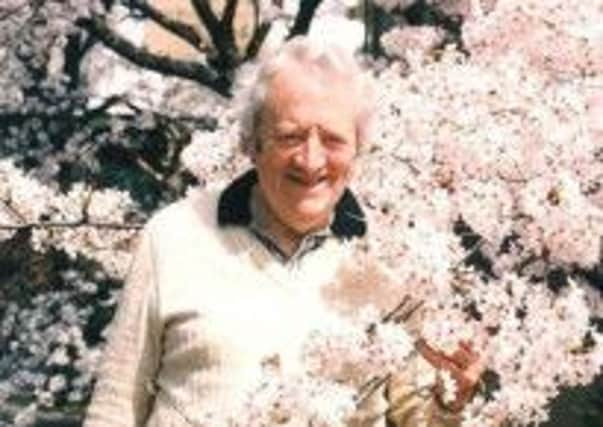Obituary: John Drewry, Scottish dance deviser and academic


In the world of dance, international fame is usually accorded to the performers and not to the choreographers, but in the case of John Drewry, who has died in his 91st year, he is hailed as one of the greatest devisers of Scottish country dances in the many countries in which enthusiasts take to the floor in tartan attire and pumps.
The Royal Scottish Country Dance Society (RSCDS) was founded by Miss Jean Milligan and Mrs Ysobel Stewart in 1923, the year, coincidentally, of John Drewry’s birth.
Advertisement
Hide AdAdvertisement
Hide AdIn collaboration with other enthusiasts, Miss Milligan collected old dances which, in some instances, she amended, publishing them in a regular series of instruction books. Many of these dances were old favourites. The first dance in Book 1, published in 1924, was the reel Petronella, noted as having been “Introduced by Nathaniel Gow at his Annual Ball, in Edinburgh, 1820”, where Sir Walter Scott might well have been an admiring spectator.
The formations and steps of these dances were limited, and it was not until John Drewry appeared on the dance floor (along with several other notable devisers, such as James B Cosh, begetter in 1959 of that favourite and sometimes frenetic reel Mairi’s Wedding), that new and challenging forms and dances were created.
Born in Melton Mowbray in a 15th-century thatched cottage, Drewry first took up Scottish country dancing in Cumbria as a member of a ramblers group. He joined the RSCDS Carlisle branch and was awarded the society’s teaching certificate. It was Hugh Foss, another distinguished dance deviser, who encouraged Drewry to begin to create dances during his sojourn in Cumbria.
Drewry’s appointment to the biochemistry department of the University of Aberdeen in the mid-1960s brought him to the national heartland of Scottish country dancing and inspired him to devote more and more of his leisure time to devising dances of subtlety and distinction. It has been asserted that scientific and mathematical brains are better equipped to create new dances, since they perceive patterns, and this facility, combined with an appreciation of music, assisted Drewry’s inspiration.
The first of his dances to be published by the RSCDS was in 1984, the strathspey Silver Tassie, with its new figure the Rondel. Jean Milligan, a hard lady to please, bestowed on Drewry the affectionate title “Mr Rondel” when he attended her classes at summer school in St Andrews. In 1999, when Drewry was awarded an RSCDS Scroll for his contribution to Scottish country dancing, nine of his dances had appeared in RSCDS books, and since then the society has published four more, not to mention dances using the formations for which he is the creator: the rondel; set and rotate; corners pass and turn; and petronella in tandem.
To watch these figures – some of them challenging – being executed with skill and pleasure at a dance in the Younger Hall, St Andrews, during the annual RSCDS international Summer School must have given their deviser, sitting up on the balcony in his later frailer years, much satisfaction.
Other dances, not adopted by the RSCDS, are found in books associated with Drewry, and feature regularly on dance programmes, as, for instance, the topical medley Thirteen Fourteen (1314), its interlocking reels perhaps suggesting the complex manoeuvres at Bannockburn.
Jean Martin is a former chairman of the RSCDS. She recalls: “When devising a dance it was usually the pattern of the dance which came first, though occasionally it was a tune, a place or a particular situation which prompted John to put pen to paper. Along with gardening and photography, another of John’s leisure interests was hillwalking, and he often found his inspiration in the Scottish mountains. That is how the reel Bana came about. John was camping at Strontian beside Loch Sunart, listening to a Scottish dance programme on Radio Scotland, when the tune Bana was played. He told me: ‘I like the tune very much indeed and as I listened I worked out the shape of the dance, walking it out on the shore.’”
Advertisement
Hide AdAdvertisement
Hide AdJohn Drewry has left a legacy of more than 800 dances, including more recently devised ones such as Glover’s Reel, written in 1998 to recognise the Scottish Samurai and for a visit to Japan; also of Africa, to celebrate the golden wedding of a couple, now living in Banchory, who spent many years in Africa.
Not all of his dances have been successful and have secured a permanent place in the repertoire. However, there are well-loved classics such as the strathspey Autumn in Appin, devised by Drewry in 1982, its title referring to the memorial service for Mrs Ysobel Stewart of Fasnacloich, Appin, co-founder of the RSCDS. Autumn in Appin is a creation of genius, enhanced by the original tune The Hills of Lorne, Charlie Hunter’s haunting air composed for the Oban and Lorne Strathspey and Reel Society of which he was the revered founder.
A courteous, modest bachelor, John Drewry is survived by his sister Mary Hulse.
He will be remembered with affection and admiration, and his creations will continue to be danced from Tayport to Tokyo, wherever dedicated Scottish country dancers lace up their pumps. His poetic epitaph, “Welcome great dream maker”, comes from the fitting heading on a dance programme when John was teaching in Japan.